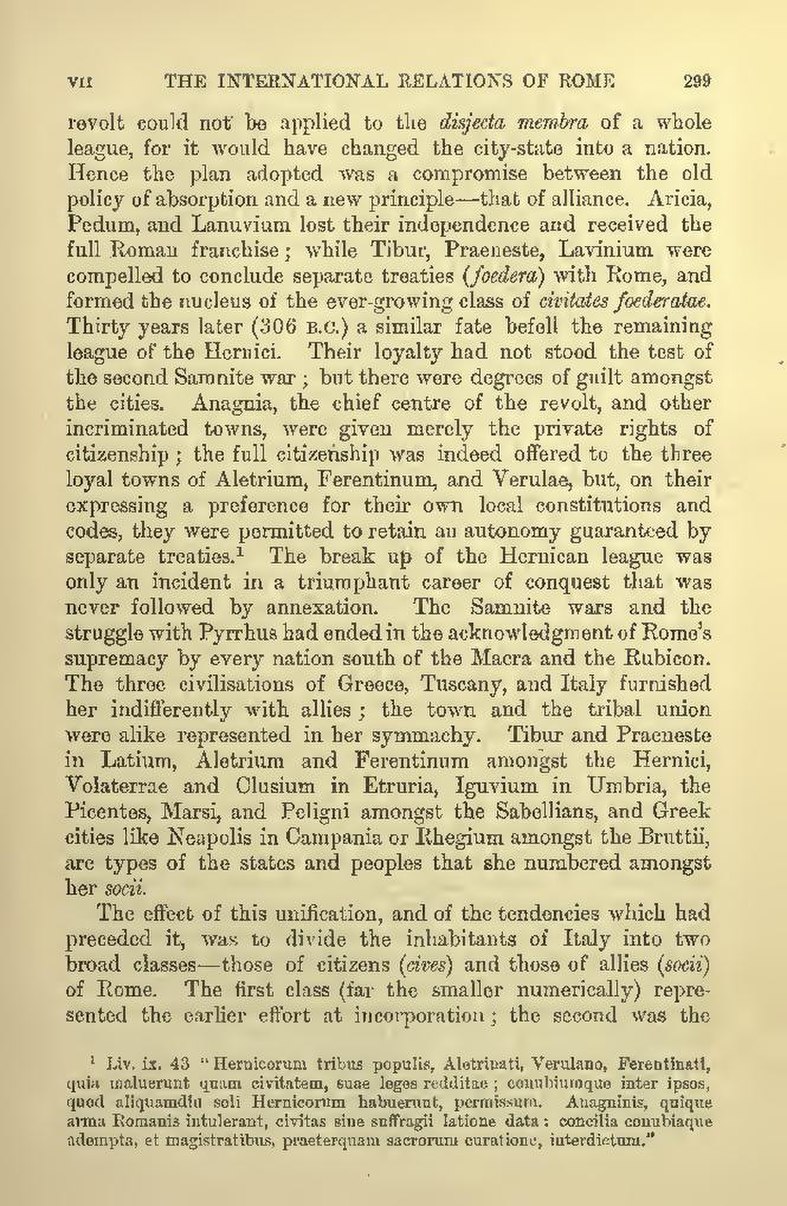revolt could not be applied to the disjecta membra of a whole league, for it would have changed the city-state into a nation. Hence the plan adopted was a compromise between the old policy of absorption and a new principle—that of alliance. Aricia, Pedum, and Lanuvium lost their independence and received the full Roman franchise; while Tibur, Praeneste, Lavinium were compelled to conclude separate treaties (foedera) with Rome, and formed the nucleus of the ever-growing class of civitates foederatae. Thirty years later (306 B.C.) a similar fate befell the remaining league of the Hernici. Their loyalty had not stood the test of the second Samnite war; but there were degrees of guilt amongst the cities. Anagnia, the chief centre of the revolt, and other incriminated towns, were given merely the private rights of citizenship; the full citizenship was indeed offered to the three loyal towns of Aletrium, Ferentinum, and Verulae, but, on their expressing a preference for their own local constitutions and codes, they were permitted to retain an autonomy guaranteed by separate treaties.[1] The break up of the Hernican league was only an incident in a triumphant career of conquest that was never followed by annexation. The Samnite wars and the struggle with Pyrrhus had ended in the acknowledgment of Rome's supremacy by every nation south of the Macra and the Rubicon. The three civilisations of Greece, Tuscany, and Italy furnished her indifferently with allies; the town and the tribal union were alike represented in her symmachy. Tibur and Praeneste in Latium, Aletrium and Ferentinum amongst the Hernici, Volaterrae and Clusium in Etruria, Iguvium in Umbria, the Picentes, Marsi, and Peligni amongst the Sabellians, and Greek cities like Neapolis in Campania or Rhegium amongst the Bruttii, are types of the states and peoples that she numbered amongst her socii.
The effect of this unification, and of the tendencies which had preceded it, was to divide the inhabitants of Italy into two broad classes—those of citizens (cives) and those of allies (socii) of Rome. The first class (far the smaller numerically) represented the earlier effort at incorporation; the second was the
- ↑ Liv. ix. 43 "Hernicorum tribus populis, Aletrinati, Verulano, Ferentinati, quia maluerunt quam civitatem, suae leges redditae; conubiumque inter ipsos, quod aliquamdiu soli Hernicorum habuerunt, permissum. Anagninis, quique arma Romanis intulerant, civitas sine suffragii latione data: concilia conubiaque adempta, et magistratibus, praeterquam sacrorum curatione, interdictum."
